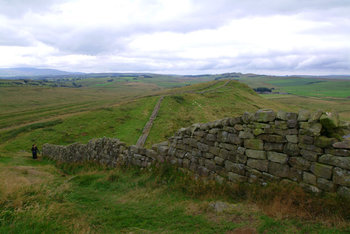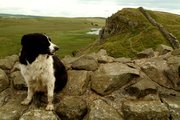Hadrian's Wall
|
|
Hadrian's Wall (in Latin: Vallum Hadriani) was a stone and turf fortification, built by the Romans across the width of Great Britain to prevent military raids by the Pictish tribes of Scotland to the north, to improve economic stability and provide peaceful conditions in the south, to define the frontier physically and to separate the unruly Selgovae tribe in the north from the Brigantes in the south and discourage them from uniting.
The name is also sometimes used as a euphemism for the border between Scotland and England, despite its not following the modern border.
The wall was the northern border of the Empire in Britain for most of the Roman Empire's rule, and also the most heavily fortified border in the Empire. In addition to its use as a military fortification, it is thought that the gates through the wall would also have served as customs posts to allow trade to be taxed.
A significant portion of the wall still exists, particularly the mid-section, and for much of its length, the wall can be followed on foot. It is the most popular tourist attraction in Northern England, where it is often known simply as the Roman Wall. It was made a UNESCO World Heritage Site in 1987. English Heritage describes it as "the most important monument built by the Romans in Britain". [1] (http://accessibility.english-heritage.org.uk/default.asp?wci=Node&wce=8410)
| Contents |
Route
Hadrian's Wall ran for 120 km, virtually due west, from Wallsend on the River Tyne to the shore of the Solway Firth. The A69 and B6318 roads largely follow the course of the wall as it starts in Newcastle-on-Tyne to Carlisle, then on round the northern coast of Cumbria. The wall is entirely in England and south of the border with Scotland by 15 km in the west and 110 km in the east.
Hadrian
Hadrian's Wall was built following a visit by Roman emperor Hadrian. Hadrian was experiencing military difficulties not just in Britain, but from the peoples of various conquered lands across the Empire, including Egypt, Judea, Libya, Mauretania, and many of the peoples conquered by his predecessor Trajan, so was keen to impose order. However the construction of such an impressive wall was probably also built as a symbol of Roman power, both in occupied Britain and in Rome.
Frontiers in the early empire were based more on natural features or fortified zones with a heavy military presence. Military roads or limes often marked the border, with forts and signal towers spread along them and it was not until the reign of Domitian that the first solid frontier was constructed, in Germania Superior, using a simple fence. Hadrian expanded on this idea, redesigning the German border by ordering a continuous timber palisade supported by forts behind it. Although such defences would not have held back any concerted invasion effort, they did physically mark the edge of Roman territory and go some way to providing a degree of control of who crossed the border and where they did it.
Hadrian reduced Roman military presence in the territory of the Brigantes and concentrated on building a more solid linear fortification to the north of them. This was intended to replace the Stanegate road which had previously served as the limes.
Construction
Construction started in 122 and was largely completed within ten years, with soldiers from all three of the occupying Roman legions participating in the work. The route chosen largely paralleled the nearby Stanegate road from Carlisle to Corbridge, which was already defended by a limes and several auxiliary forts, including Vindolanda.
The initial plan called for a ditch and wall with 80 small, gated milecastle forts every Roman mile holding a few dozen troops each, and pairs of intermediate turrets used for observation and signaling. The wall was initially designed to a width of 3 metres (the so-called "Broad Wall"). The height is estimated to have been around 5 or 6 metres. Local limestone was used in the construction, except for the section to the west of Irthing where turf was used instead as there were no useful outcrops nearby. The turf wall was 6 metres wide and around 3.5m high. Milecastles in this area were also built from timber and earth rather than stone.
The milecastles were of three different designs, depending on which Roman legion built them--the Second, Sixth, and Twentieth Legions, whose inscriptions tell us were all involved in the construction. Similarly there are three different turret designs along the route. All were about 493m apart and measured 4.27m square internally.
Construction was divided into lengths of about 5 miles. One group of each legion would create the foundations and build the milecastles and turrets and then other cohorts would follow, building the wall itself. Early in its construction the width of the wall was narrowed to 2.5 metres or even less (the "Narrow Wall"). The Broad Wall dimensions can be seen in some stretches of foundations and some milecastle walls-- a handy reference for archaeologists trying to piece together the construction chronology.
Within a few years it was decided to add a total of 14 full-sized forts along the length of the wall, including Housesteads and Birdoswald, each holding between 500 and 1000 auxiliary troops (no legions were posted to the wall). The eastern end of the wall was extended further east from Pons Aelius (Newcastle) to Wallsend on the Tyne estuary. Some of the larger forts along the wall, such as Chesters and Housesteads, were built on top of the footings of milecastles or turrets, showing the change of plan. An inscription mentioning early governor Aulus Platorius Nepos indicates that the change of plans took place early on. Also sometime still during Hadrian's reign (i.e., before 138 AD) the Wall west of the Irthing was rebuilt in sandstone to basically the same dimensions as the limestone section to the east.
After the forts had been added (or possibly at the same time), the so-called Vallum was built on the southern side. It consisted of a large, flat bottomed ditch 6m wide at the top and 3m deep bounded by a berm on each side 10m wide. Beyond the berms were earth banks 6m wide and 2m high. Causeways crossed the ditch at regular intervals. Initially the berm appears to have been the main route for transportation along the wall. The Vallum probably delineated a military zone rather than intending to be a major fortification, though the British tribes to the south were also sometimes a military problem.
The Wall was thus part of a defensive system which, from north to south included:
- a glacis and a deep ditch armed with rows of pointed stakes
- the Wall itself
- a later military road (the "Military Way")
- the Vallum—two huge banks with a ditch between.
Garrison
The wall was garrisoned by auxiliary (i.e., non-legionary) units of the army (non-citizens). Their numbers fluctuated throughout the occupation, but may have been around 9,000 strong in general, including infantry and cavalry. The new forts could hold garrisons of 500 men whilst cavalry units of 1000 troops were stationed at either end. The total number of soldiers manning the early wall was probably greater than 10,000.
They suffered serious attacks in 180, and especially between 196 and 197 when the garrison had been seriously weakened, following which major reconstruction had to be carried out under Septimius Severus. After the harsh suppression of the tribes under Septimius, the region near the wall remained peaceful for most of the rest of the 200s. It is thought that many in the garrison may have married and integrated into the local community.
After Hadrian
In the months after Hadrian's death in 138, the new emperor, Antoninus Pius essentially abandoned the wall, though leaving it occupied in a support role, and began building a new wall in Scotland proper, about 100 miles north, the Antonine Wall. This turf wall ran 40 Roman miles (about 37 modern miles) and had significantly more forts than Hadrian's Wall. Antonine was unable to conquer the picts and so when Marcus Aurelius became emperor, he abandoned the Antonine Wall and occupied Hadrian's Wall once again in 164. It remained occuped by Roman troops until their withdraw from Britain.
In the late 4th century, barbarian invasions, economic decline, and military coups loosened the Empire's hold on Britain. By 410, the Roman administration and its legions were gone, and Britain was left to look to its own defenses and government. The garrisons, by now probably made up mostly of local Britons who had nowhere else to go, probably lingered on in some form for generations. Archaeology is beginning to reveal that some parts of the Wall remained occupied well into the 5th century. But in time the wall was abandoned and fell into ruin. Over the centuries a large proportion of the stone was reused in other local buildings. This continued until the 20th century.
Other fortifications
The first Roman fortification in Scotland was the Gask Ridge, a series of forts north of the Clyde and Forth estuaries in Perthshire. This was soon abandoned for Hadrian's Wall. Fifteen years after completion of the Hadrian's Wall, a turf fortification, the Antonine Wall, was built to run between the Clyde and Forth. This wall was considerably shorter than Hadrian's Wall, but was manned by roughly the same number of troops. In some ways the Antonine Wall was more sophisticated, including large platforms for ballista. Within one generation the Antonine Wall had been abandoned, and Hadrian's Wall was reoccupied.
See also
- Roman invasion of Britain
- Roman Britain
- History of Scotland
- English Heritage Properties in England
- Birdoswald Fort
- Banks East Turret
- Hadrian's Wall long-distance footpath
- Antonine Wall
- Gask Ridge
- List of walls
References
- Forde-Johnston, James L. Hadrian's Wall. London: Michael Joseph, 1978. ISBN 0718116526.
External links
es:Muralla de Adriano fr:Mur d'Hadrien it:Vallo di Adriano nl:Muur van Hadrianus ja:ハドリアヌスの長城 pl:Mur Hadriana pt:Muralha de Adriano fi:Hadrianuksen valli sv:Hadrianus mur zh:哈德良长城
Categories: World Heritage Sites in England | Ancient Roman architecture | Archaeological sites in Britain | Fortification | Walls | Buildings and structures in Cumbria | Visitor attractions in Cumbria | Northumberland | Visitor attractions in Tyne and Wear | Buildings and structures in Tyne and Wear | Nerva-Antonine Dynasty | Roman sites in England | Separation barriers


